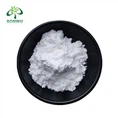Fmoc-OSu Powder, also known as 9-Fluorenylmethoxycarbonyl N-hydroxysuccinimide ester, is a reagent commonly used in the field of peptide synthesis. It is utilized for the protection and activation of amino acids during solid-phase peptide synthesis. Fmoc is a chemical group that protects the amine function of an amino acid, and OSu (N-hydroxysuccinimide ester) is a reactive group that facilitates the coupling of the protected amino acid to the growing peptide chain. Overall, Fmoc-OSu plays a crucial role in the step-by-step assembly of peptides on a solid support, allowing for the controlled addition of amino acids in the desired sequence.

What is the use of Fmoc OSu
Fmoc-OSu, also known as 9-Fluorenylmethoxycarbonyl N-hydroxysuccinimide ester, is commonly used in the field of peptide synthesis. It acts as a reagent for the protection and activation of amino acids during solid-phase peptide synthesis.
In peptide synthesis, Fmoc-OSu is utilized for the following purposes:
1. Protection of Amino Groups: The Fmoc group protects the amine function of an amino acid, preventing unwanted reactions at this site during the synthesis process.

2. Activation of Amino Acids: The OSu (N-hydroxysuccinimide ester) moiety on Fmoc-OSu facilitates the coupling of protected amino acids to growing peptide chains. It is involved in the formation of an amide bond between amino acids, crucial for extending the peptide chain.
Overall, Fmoc-OSu plays a critical role in the controlled assembly of peptides on a solid support. It allows for the sequential addition of amino acids in a desired order during solid phase peptide synthesis.
Why is Fmoc used in peptide synthesis
Fmoc (9-Fluorenylmethoxycarbonyl) is a commonly used protecting group in peptide synthesis due to several advantageous properties it offers:
1.Orthogonal Deprotection: Fmoc can be selectively removed under mild basic conditions (e.g., with piperidine), leaving other protecting groups like side chain protections intact. This allows for stepwise deprotection of individual amino acids in a synthetic peptide sequence.
2. Solid-phase Synthesis Compatibility: Fmoc chemistry is well-suited for solid-phase peptide synthesis, as Fmoc deprotection reactions are compatible with the resin-bound peptide. This enables the stepwise addition of amino acids to the growing peptide chain.

3. Solubility: Peptides synthesized using the Fmoc strategy are typically soluble in common organic solvents, making purification steps more manageable.
4.High Coupling Yields: Fmoc-based peptide synthesis typically results in high coupling yields, leading to efficient construction of peptide sequences with minimal formation of undesired byproducts.
5. Commercial Availability: Fmoc-protected amino acids and related reagents are readily available commercially, offering convenience and accessibility of necessary building blocks for peptide synthesis.
6. Compatibility with solid-phase synthesis: Fmoc-based solid-phase peptide synthesis is widely used due to the compatibility of Fmoc deprotection conditions with the resin-bound peptide, enabling the stepwise addition of amino acids to the growing peptide chain.

7. Mild Reaction Conditions: Fmoc deprotection reactions can be carried out under mild conditions, reducing the likelihood of undesired side reactions or modifications to sensitive amino acid side chains.
Overall, the versatility, selectivity, and compatibility of Fmoc chemistry make it a preferred choice in peptide synthesis, allowing for the efficient construction of complex peptide sequences with precise control over each step.
What conditions are required to remove Fmoc
The 9-fluorenylmethyloxycarbonyl (Fmoc) protecting group is commonly removed under mild basic conditions during solid-phase peptide synthesis. The standard procedure for Fmoc deprotection involves the use of a base, typically piperidine, in an organic solvent such as N,N-dimethylformamide (DMF) or a mixture of DMF and a co-solvent like dichloromethane.
A common method for Fmoc deprotection involves treatment with a solution of piperidine in DMF. The reaction is typically carried out for a short duration, often a few minutes, at room temperature or slightly elevated temperatures. The nature of the Fmoc-protected amino acid and the particular requirements of peptide synthesis can be taken into consideration while adjusting the temperature, reaction time, and piperidine concentration.

Following the deprotection step, the Fmoc group is selectively removed from the N-terminus of the growing peptide chain, leaving the side-chain protecting groups and the peptide backbone intact. The deprotected site can then be utilized for the next step in peptide elongation or additional manipulations as part of the synthetic process.
It's worth noting that the conditions for Fmoc deprotection can vary depending on the specific peptide sequence, the nature of the Fmoc-protected amino acid, and other factors in the synthesis protocol. Therefore, it's essential to refer to established methods and literature specific to the peptide synthesis being performed.
If you want to know more about this product, feel free to contact Xi'an Sonwu.
Email: sales@sonwu.com





